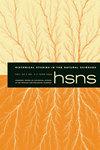The Human Genome Project as a Singular Episode in the History of Genomics
IF 0.3
3区 哲学
Q2 HISTORY & PHILOSOPHY OF SCIENCE
引用次数: 2
Abstract
In this paper, we progressively de-center the Human Genome Project (HGP) in the history of genomics and human genomics. We show that the HGP, understood as an international effort to make the human reference genome sequence publicly available, constitutes a specific model of genomics: prominent and influential but nevertheless distinct from others that preceded, existed alongside, and succeeded it. Our analysis of a comprehensive corpus of publications describing human DNA sequences submitted to public databases from 1985 to 2005 reveals a plethora of authoring institutions, with only a few contributing to the HGP. Examining these publications in a co-authorship network enables us to propose two different sequencing approaches—horizontal and vertical sequencing—whose changing dynamics shaped the history of human genomics. We argue that investigating the extent to which different institutions combined these approaches or prioritized one of them captures the history of genomics better than using the categories of large-scale sequence production and sequence use, as much scholarly literature concerning the HGP has done. Sequence production and use became fully distinct only within the HGP model, and especially during the last stages of this endeavor. By exploring a collaboration between Celera Genomics, a large-scale sequencing institution, and two medical genetics laboratories, we show the potential of our co-authorship network and its analysis for historical research. Our study connects the historiographies of medical genetics and human genomics and indicates that the so-called translational gap from sequence data to clinical outcomes may reflect the assumption that genomics was substantially different from prior and parallel genetics research. This essay is part of a special issue entitled The Sequences and the Sequencers: A New Approach to Investigating the Emergence of Yeast, Human, and Pig Genomics, edited by Michael García-Sancho and James Lowe.人类基因组计划是基因组学历史上的一个特殊事件
在本文中,我们逐步去中心化人类基因组计划(HGP)在基因组学和人类基因组学的历史。我们表明,人类基因组计划是一项国际努力,旨在使人类参考基因组序列公开可用,它构成了基因组学的一个特定模型:突出和有影响力,但与之前的其他模型不同,与之共存,并继承了它。我们对1985年至2005年提交到公共数据库的描述人类DNA序列的出版物的综合语料库进行了分析,发现作者机构过多,只有少数机构为HGP做出了贡献。在一个合著者网络中检查这些出版物使我们能够提出两种不同的测序方法——水平测序和垂直测序——它们的变化动态塑造了人类基因组学的历史。我们认为,研究不同机构结合这些方法或优先考虑其中一种方法的程度,比使用大规模序列产生和序列使用的分类更好地捕捉了基因组学的历史,正如许多关于人类基因组计划的学术文献所做的那样。序列的生产和使用只有在HGP模型中才完全不同,特别是在这一努力的最后阶段。通过探索大型测序机构Celera Genomics与两个医学遗传学实验室之间的合作,我们展示了我们的合作网络及其对历史研究的分析的潜力。我们的研究将医学遗传学和人类基因组学的历史编纂联系起来,表明所谓的从序列数据到临床结果的翻译差距可能反映了基因组学与先前和平行的遗传学研究有很大不同的假设。这篇文章是由Michael García-Sancho和James Lowe编辑的题为“序列和测序者:研究酵母、人类和猪基因组学出现的新方法”的特刊的一部分。
本文章由计算机程序翻译,如有差异,请以英文原文为准。
求助全文
约1分钟内获得全文
求助全文
来源期刊

Historical Studies in the Natural Sciences
社会科学-科学史与科学哲学
CiteScore
1.00
自引率
0.00%
发文量
24
审稿时长
>12 weeks
期刊介绍:
Explore the fascinating world of Historical Studies in the Natural Sciences, a journal that reveals the history of science as it has developed since the 18th century. HSNS offers in-depth articles on a wide range of scientific fields, their social and cultural histories and supporting institutions, including astronomy, geology, physics, genetics, natural history, chemistry, meteorology, and molecular biology. Widely regarded as a leading journal in the historiography of science and technology, HSNS increased its publication to five times per year in 2012 to expand its roster of pioneering articles and notable reviews by the most influential writers in the field.
 求助内容:
求助内容: 应助结果提醒方式:
应助结果提醒方式:


